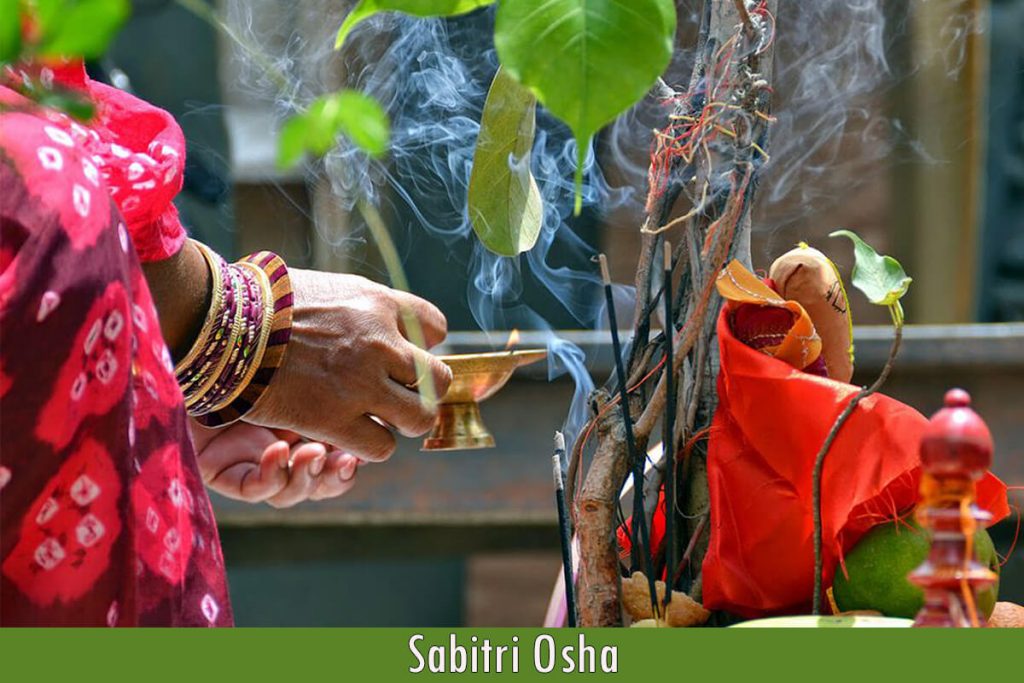Sabitri Osha (also known as Sabitri Brat or Sabitri Amavasya) is an Osha celebrated by sadhva women in Odisha. Savitri Sadhvi is the ideal of a woman; So it is good for the longevity of her husband, Sadhva women observe this Osha to be sadhva for life like Savitri. Savitri Osha is celebrated on the first day of the new moon. On this day, sadhva women fast, do not eat, and in the afternoon, when the puja is over (smoke, coconut, plantain (rambha), mango, pineapple, sapuri, talasaj, etc.). For this reason, the Sabitri anecdote is recited during the Brotsava celebrations at the base of Chura or at Thakur’s house. In fact, the worshiped goddess of this puja is Maa Savitri. Sabitri Brahma’s wife, Gayatri, the sun-goddess. Mother Savitri is glorified on the basis of how Goddess Savitri’s blessings and mercy on the human Sabitri brought the faithful back from the brink of death.
According to the Mahabharata, a king named Ashwapati ruled in the land of Madhya Pradesh. She once performed a sacrifice to get Savitri Devi as a bride. Arriving at the appointed time, the goddess appeared to the horse and asked the bridegroom to ask for the desired bridegroom. As the king was childless, he begged the goddess for a son. The goddess indicated to the king that she did not want to have a son, and disappeared with the blessing of being a good daughter. At the right time, by the grace of the Goddess, a girl was born in the arms of the horse’s wife. After worshiping Savitri (Gayatri), Savitri got a daughter from her blessings and named her Savitri. After her youth, Gayatri agreed to find a bridegroom of her own accord on the orders of her father, Ashwapati, and set out on a journey with her companions in search of her husband. Satyavana was born from the womb of Shaiva in the womb of King Dumassen of Salvador. In the early days of Satyaban’s childhood due to a natural disaster, Dumatsen became a blind and corrupt state and became a forest dweller. In devotion to the forest, he ate the fruit and served his parents with devotion.
While traveling, Savitri arrived in the forest, fascinated by Satyaban’s infinite patriotism, devotion and form, decided to give up her life and live with her, and returned to the capital, choosing Satyaban as her husband. At this point, Narad appeared and asked Sabitri to change her mind, stating that Satyaban’s life was only one year away. But Sabitri rejected the offer and remained steadfast in her decision. With the permission of the parents of both parties, Sabitri’s marriage to Satyaban was solemnized. After the marriage, Savitri left the royal estate of the ancestral house, the luxury and the slave class, and lived with her husband in the hut of Tapoban, in the service of her mother-in-law and father-in-law.
Three days before the one-year anniversary of the marriage, Savitri observed the three-night vow. On the day when it would be a year old and the life of the faithful was over, Sabitri went with him as he went to the forest to collect the true fruits and praises. Feeling restless in the forest, Sabitri fell asleep with her head in her lap and fell asleep. But Savitri kept her dead husband’s head on her lap and sat there. The messengers came to take the life of Satyaban and returned without being able to snatch it from Sadhvi Savitri. Upon hearing the news of the failed ambassador, Yam himself arrived and grabbed the living creature. Savitri also followed Yam. Satisfied with her husband’s devotion and praise, Yamaraja agreed to give three brides in lieu of Satyabana, stipulating that she could ask for anything else in return for Satyaban’s life. He regained his father-in-law’s lost eyes and heart in the first marriage, a son in his second marriage, and a hundred sons in his womb in the third marriage. When she asked him to return, Sabitri asked how she could have a hundred sons without her husband, and Agatya became helpless and revived the truth.
Comments
comments
